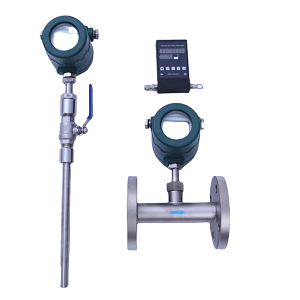There are two dominant types of mass flowmeters in today's current market - thermal mass and Coriolis mass flow meter
Coriolis mass flowmeters measure the mass flowrate of a fluid travelling through a tube. The mass flowrate is the mass of a fluid moving past a fixed point per unit time.
Thermal dispersion flow meters determine the mass of gas molecules effectuating heat transfer to derive a flow measurement.
If the density remains constant, the relationship is simplified. Fluid density variations make the relationship less simple. Fluid density may differ with temperature, pressure or composition. For instance, the fluid may also be a combination of phases such as a fluid with entrained bubbles.
Mass flow measurement devices essentially eliminate several potential complications linked to correcting for temperature /pressure variation. For instance, in gas flow measurement the common measurements units are volumetric flow meter units that are corrected to base conditions or standard temperature and pressure (STP). The results are achievable through various technologies equipped with a multi-variable flow transmitter or done through the control system or a flow computer
Mass flow meter devices output in volumetric /mass units at STP or base conditions as a standard offering eliminating the added pressure and temperature correction needed on the end-users part. For instance, in the gas industry, the standard cubic feet per hour (SCFH) is a common unit that is corrected back to base conditions. In USA's oil and gas industry, it is normal to have base temperature and pressure for natural gas of 60 F and 1 atm.
Having a set of base conditions facilitates consistent reporting of flows /volumes that will not vary due to operating conditions.
Thermal dispersion flow meters launch heat into the flow stream and determine the rate of heat dispersion using one or several temperature sensors.
This method best suits gas flow rate because liquids possess higher heat retention capacity that saturates the signal rapidly resulting in loss of measurement determination
Coreolis mass flowmeters employ a curved or straight-tube sensor applying the second law of motion of Newton to measure the flow rate. The centre of the tube end (if it is a bent-tube)contains a drive coil that is electromagnetic that causes vibrations like a tuning fork.The inner and outer vents of the sensor contain a pickoff coil which generate electromotive force simultaneously with each other at no -flow conditions.The voltage created by pickoff coils due to the introduction of flow into the sensor will occur deferentially, creating a phase shift that is measurable in time difference and directly corresponds to the mass flow in the sensor.
Thermal gas flowmeters are dynamically used in gas measurement applications, especially responding to the greenhouse gas reduction efforts including:
Biogas
Distilling and refining Ethanol
Procuring methane from coal mines
Measuring boiler's emmissions
Process steam generators and heaters
Measuring the recovery of landfill gases
Measuring and monitoring flare and flue gases
Coriolis flowmeters can measure liquids and gas but operate easier with liquids. Liquids flow measurement has an absolute advantage over gases due to their density which allows them to deflect the flowtube alongside the meters reliance on fluid momentum.
The straight-tube flow sensor meters suppliers face challenges applying them to gas flow measurement. Downstream applications use coriolis flowmeters for petroleum liquids, where they are displacing positive-displacement meters in certain applications. Their distinguishing feature being absence of moving parts in the former, besides tube vibration. Straight-tube meters comparative advantage over bent-tube meters is the nearly absent pressure drop and lack of fluid build-up.
Coriolis flowmeters unlike Thermal mass flowmeters have the best accuracy and are utilized in custody transfer of petroleum liquids and gases.
The latter are cheaper to manufacture making them an excellent fit for non-custody transfer gas measurements where top-rated accuracies aren’t required. This class is responsible for some compelling technological innovations beginning with their introduction into the market arena in the 1970 s till date.
The campaign to measure greenhouse gas emissions alongside energy management applications is boosting the market of the thermal flowmeter
Suppliers have responded by introducing feature rich-products to enhance performance levels ,in terms of improved flow sensitivity , and enhanced computing for field measurement and verification thereby eliminating the need for external hardware .
 Bent tube Coriolis flow meter2019/07/22Smaller installation size.
Bent tube Coriolis flow meter2019/07/22Smaller installation size. Coriolis mass flow meter2019/06/12Best accuracy flow meter
Coriolis mass flow meter2019/06/12Best accuracy flow meter Micro low flow Coriolis flow meter2019/06/05Min flow 0-10 kg/hr
Micro low flow Coriolis flow meter2019/06/05Min flow 0-10 kg/hr Thermal Mass Flow Meter2017/05/27Low cost gas flow meter.
Thermal Mass Flow Meter2017/05/27Low cost gas flow meter. Insertion type thermal mass flow sensor2019/06/14Insertion gas flow sensor and easy install.
Insertion type thermal mass flow sensor2019/06/14Insertion gas flow sensor and easy install. Micro-Flowrate Thermal Mass Flow Meter2018/03/02Micro-flowrate Thermal mass flow meter
Micro-Flowrate Thermal Mass Flow Meter2018/03/02Micro-flowrate Thermal mass flow meter